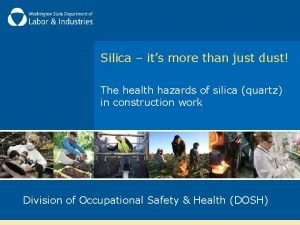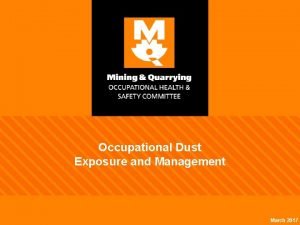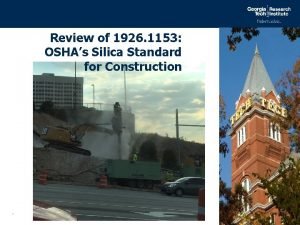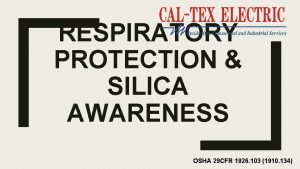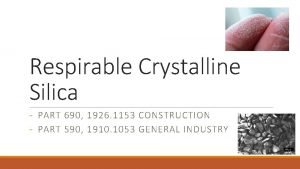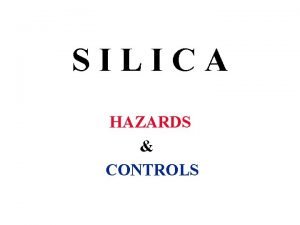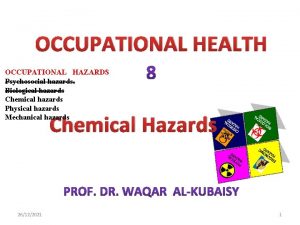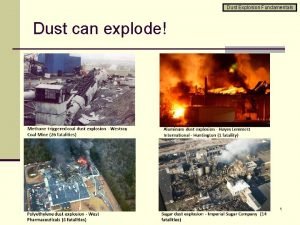HEALTH HAZARDS Silica Dust Volume 2 Issue 53






- Slides: 6

HEALTH HAZARDS || Silica Dust Volume 2 Issue 53 Nearly 300, 000 industry workers in the United States are exposed to Silica Dust on the job. Workers that inhale crystalline silica are at increased risk of developing silica-related diseases that can be debilitating or even fatal. Protective steps must be taken to prevent, reduce and measure exposure levels to silica dust to ensure the safety of all workers. Crystalline Silica is a common mineral found in the ground. When products or materials are harvested, manufactured or produced from natural elements of the Earth, these materials may then contain silica. OSHA Standard 1910 Subpart Z Section 1053 covers Respirable Crystalline Silica A written exposure control plan should be part of the workplace safety and health program for any organization that has employees that could potentially be exposed to silica dust. Common materials found at work sites that may contain crystalline silica include sand, stone, rock, concrete, brick, mortar and block. Silica is also found in products like glass, pottery and ceramics. Follow the recommendations in this topic to ensure you are taking precautions when it comes to exposure to silica dust on the job. © Weeklysafety. com, LLC (*1) Granite may contain up to 45 -50% silica. 1

HEALTH HAZARDS || Silica Dust Volume 2 Issue 53 Respirable crystalline silica dust is created during normal industry and manufacturing activities when cutting, sawing, grinding, drilling or crushing any material that has silica like granite, ceramics and stone. The super-fine silica particles are released into the air and workers are in danger of inhaling these silica dust and developing serious health conditions as a result. Typical manufacturing and processing activities that release silica dust into the air: • manufacturing glass, pottery, or ceramics • manufacturing brick, concrete or structural clay products • manufacturing artificial stone, jewelry or porcelain products • using handheld powered chipping tools • manufacturing stone countertops • using industrial sand in foundry work and hydraulic fracturing • using sand for abrasive blasting OSHA Standard 1910. 1053(c) Permissible exposure limit (PEL). The employer shall ensure that no employee is exposed to an airborne concentration of respirable crystalline silica in excess of 50 μg/m 3, calculated as an 8 -hour time-weighted average (TWA). © Weeklysafety. com, LLC (*2) (*4) (*3) 2

HEALTH HAZARDS || Silica Dust Volume 2 Issue 53 Workers who inhale silica dust particles are at an increased risk of developing certain illnesses including: • Silicosis – an incurable lung disease • Kidney Disease • Tuberculosis • Lung Cancer • Chronic Obstructive Pulmonary Disease (COPD) Take Tip! adv healt antage of scree h and lung ning p ro offere grams d. OSHA Standard 1910. 1053(f)(1) Engineering and work practice controls. The employer shall use engineering and work practice controls to reduce and maintain employee exposure to respirable crystalline silica to or below the PEL, unless the employer can demonstrate that such controls are not feasible. Wherever such feasible engineering and work practice controls are not sufficient to reduce employee exposure to or below the PEL, the employer shall nonetheless use them to reduce employee exposure to the lowest feasible level and shall supplement them with the use of respiratory protection. A dust mask is not enough! Respiratory protection is only permitted when other dust control measures are not sufficient. 1. Effective dust control methods must be implemented to prevent silica dust from being released into the air. 2. When dust control methods do not fully control the silica dust, then the amount of silica dust that workers are exposed to should be determined. (*5) 3. Workers must be protected from silica dust, with dust controls and safer work methods, when it is measured at or above the level of 50 μg/m 3, averaged over an 8 -hour day. 4. Respirators must be provided to workers when dust controls and safer work methods can not effectively keep exposure under 50 μg/m 3, averaged over an 8 -hour day. © Weeklysafety. com, LLC 3

HEALTH HAZARDS || Silica Dust Volume 2 Issue 53 All employers who have workers that are exposed to silica dust must establish the following and affected employees must be aware of and assist in effectively implementing these requirements. Ø A written exposure control plan must be implemented that identifies silica-exposure tasks and the methods that will be used to protect workers. Ø Housekeeping practices that expose workers to silica dust must be restricted. Ø Medical exams must be offered to employees every three years for employees who are required to wear a respirator for 30 days or more per year. Ø All workers that may be exposed to silica dust must be provided training on the health effects of silica exposure, the tasks they may encounter that would expose them to silica and the ways they can limit their exposure. Ø Records must be kept of workers silica exposure and medical exams. A worker uses a stone grinder that applies water at the work surface to reduce silica dust. (*4) A worker grinding castings in a foundry in a ventilated booth to reduce silica exposure. (*5) © Weeklysafety. com, LLC A worker uses an enclosure that isolates silica dust while abrasive blasting dental castings. (*6) 4

HEALTH HAZARDS || Silica Dust Volume 2 Issue 53 To limit exposure to harmful silica dust, these control methods can provide a safer work environment: Ø Apply water to a saw blade when cutting materials or use tools equipped with an integrated water delivery system. Ø Use tools equipped with shrouds and commercially available dust collection system. Ø Install local ventilation or use vacuums to collect dust. Ø Use enclosures that isolate the work process. Ø Avoid working in dusty work environments whenever possible and wear a respirator when needed/required. Ø Wet dust before sweeping it up or vacuum dust instead of sweeping it. Ø Do not eat or drink near dusty work areas. Ø Shower (if possible) and change into clean clothes before leaving the worksite to prevent carrying silica dust away from the work site. A worker uses an local exhaust ventilation to remove silica dust while cutting stone. (*7) OSHA Standard 1910. 1053(h)(1) The employer shall not allow dry sweeping or dry brushing where such activity could contribute to employee exposure to respirable crystalline silica unless wet sweeping, HEPA-filtered vacuuming or other methods that minimize the likelihood of exposure are not feasible. © Weeklysafety. com, LLC 5

HEALTH HAZARDS || Silica Dust Volume 2 Issue 53 COPYRIGHT AND DISCLAIMER This material is the copyrighted property of Weeklysafety. com, LLC. Purchase of this material from Weeklysafety. com, LLC grants the owner the right to use this material for workplace safety and education purposes only. Use of this material for any other purpose, particularly commercial use, is prohibited. This material, including the photos, may not be resold. Weeklysafety. com, LLC does not warrant or assume any legal liability or responsibility for the accuracy, completeness, or usefulness of any information, apparatus, product, or process disclosed in these materials. Photos shown in this presentation may depict situations that are not in compliance with applicable Occupational Safety and Health Administration (OSHA) safety requirements. These materials are meant for informational purposes only and it is not the intent of Weeklysafety. com, LLC to provide compliance-based training. The intent is more to address hazard awareness in the construction and related industries, and to recognize the potential hazards present in many workplaces. These materials are intended to discuss Federal Regulations only, as individual State requirements may be more stringent. Many states operate their own state OSHA and may have standards that are different from information presented in this training. It is the responsibility of the employer and its employees to comply with all pertinent OSHA safety rules and regulations in the jurisdiction in which they work. PHOTO ACKNOWLEDGMENTS Unless specified below, all photos are the copyrighted property of Weeklysafety. com, LLC and may not be used in any other training materials or resold for any purpose. • (*1) Photo Credit – Shutterstock; closeup-worker-who-processes-granite-using-1018417903. Standard License. • (*2) Photo Credit – Wikipedia; https: //en. wikipedia. org/wiki/File: Cutting_through_bricks. jpg; Public Domain. • (*3) Photo Credit – Shutterstock; worker-processes-granite-stone-grinder-pretreatment-1039931323. Standard License. • (*4) Photo Credit – OSHA Fact Sheet 3682. https: //www. osha. gov/Publications/OSHA 3682. pdf • (*5) Photo Credit – OSHA Fact Sheet 3683 Online. https: //www. osha. gov/silica/factsheets/OSHA_FS-3682_Silica_GIM. html • (*6) Photo Credit – OSHA Fact Sheet 3682. https: //www. osha. gov/Publications/OSHA 3682. pdf • (*7) Photo Credit – OSHA Fact Sheet 3682. https: //www. osha. gov/Publications/OSHA 3682. pdf For more information on this weekly safety topic, other topics that are available and the full list of FAQs please visit www. weeklysafety. com or email safety@weeklysafety. com. © Weeklysafety. com, LLC 6
